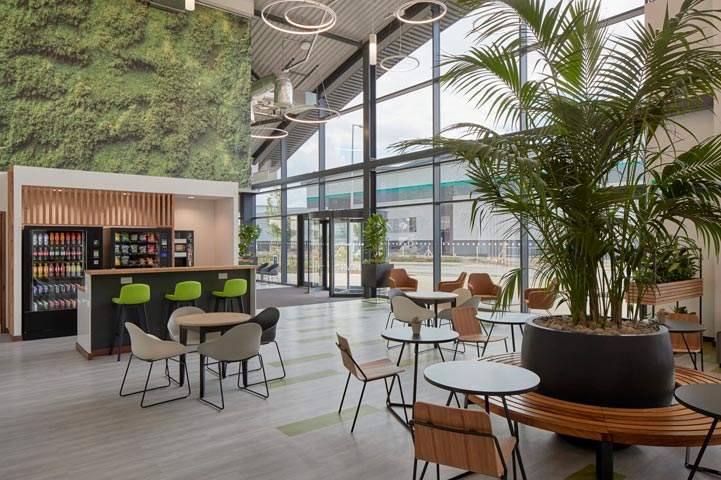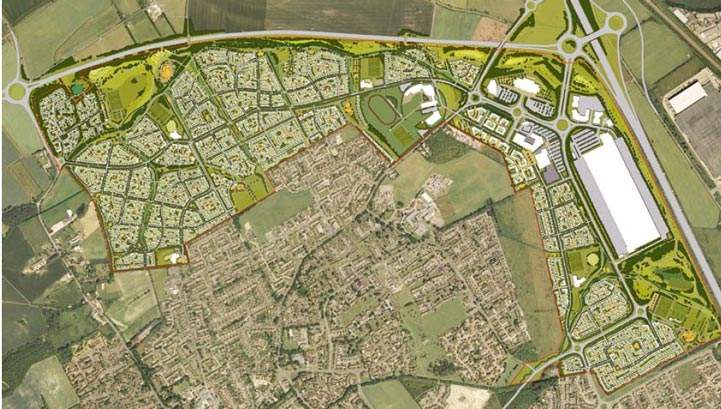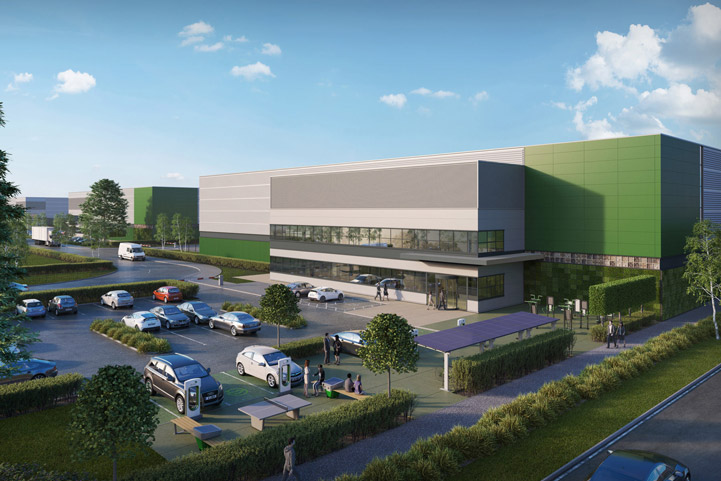I&L development generates direct and indirect jobs and substantial social value in the form of training and apprenticeships
The social value of I&L supply chains
I&L developments generate significant jobs and economic benefits as part of their wider supply chains in addition to on-site employment. In turn, these economic benefits create social value in the form of apprenticeships, training and upskilling opportunities for local people.
I&L jobs range from entry-level graduates to highly skilled engineering and management roles. This wider supply chain employment is often overlooked in favour of the higher on-site job densities for retail and office use. However, in many cases, the office and retail jobs envisaged in Local Plans are not created given these uses are unviable to build in many locations throughout the country.
In terms of wider supply chain employment, production plants and warehouses require goods to be transported and delivered between their suppliers and end-use customers. This creates the need for drivers of heavy goods vehicles (HGVs) and light goods vehicles (LGVs). LGV licences alone have increased by 83% over the last two decades26 in response to the rise in online shopping and subsequent expansion of the I&L sector. This increase in HGVs and LGVs creates jobs involved in their manufacture, maintenance and repair.
The growth of the UK’s freight industry also creates significant jobs. I&L premises are a critical link in the chain alongside the key freight modes that allow goods to enter, leave and move around the country (i.e. ports, airports, rail freight interchanges and motorways). Like warehouses and factories, these freight handling facilities generate employment to drive the planes, trains and boats, as well as jobs involved in their maintenance and repair. Jobs are also created at ports, airports and rail freight interchanges as part of their operation.
As discussed above, the sector has also increased its share significantly of professional occupations (plus 157,000) and associate professional and technical roles (plus 174,000) over the last decade. Many of these roles are involved in supply chain management, engineering linked to the sector’s increased automation, sales and marketing and even research and development into future advancements such as drone deliveries and autonomous driving vehicles.
The sector also generates significant construction and apprenticeship roles which will increase further as it expands into the future. As discussed earlier, Savills estimates future I&L needs in England to be at least an additional 44 million sq ft (net) per annum. This is an uplift of 29% against the historic 10-year trend and accounts for suppressed demand (i.e. demand that has not been accommodated historically due to the lack of available supply). This future demand, if facilitated via the bringing forward of ample land supply, will give rise to a vast construction programme that will support 45,400 jobs per annum. Of these, 400 construction apprenticeships will be created each year, delivering a social value of over £7.8 million per annum27. Based on Savills research on local procurement benefits, we expect this construction programme to generate £440 million of social value benefits for local communities28.
The I&L sector also delivers on average 41,100 apprenticeship starts per annum29. This is particularly important given the high levels of youth unemployment in England which currently stands at 14.6%30. If the sector is able to expand consistent with Savills estimate of future demand, the number of apprenticeships could grow to 53,000 starts annually; which is equivalent to over half a million apprenticeships over the next 10 years.
Case Study: From unemployed to full-time, permanent employee
Jehan’s journey to employment shows her determination to seize the opportunity enabled by I&L development at Hinckley Park and Mercia Park. Below are some excerpts from Jehan’s story as told on winvic.co.uk.
.jpg)
Jehan Gomes-Luis – Assistant Site Manager, Winvic
“Back in April 2019 I was unemployed and my Jobcentre Plus assessor told me about a jobs fair that was taking place. I spoke to a number of different organisations and businesses there, but one offering that really caught my attention was a training course being offered by North Warwickshire and South Leicestershire College, IM Properties, Winvic and a local groundworks subcontractor, which focused on groundworks and health and safety. […]
I was accepted onto the three-week course, and in June 2019, I walked into a college classroom as the only female out of 22 attendees – I didn’t feel apprehensive about this, but instead, I thought, prove you can do it and see what happens. The first week focused on employability skills, such as interview techniques, the second was all about groundworks – and this was all on-site at Hinckley Park as the earthworks were being undertaken there – and the last was back in the classroom for health and safety training, sitting exams and a job interview with a Winvic groundworks subcontractor on the project.”
Upon completion of the course, Jehan obtained her CSCS card, an employability certificate and a City and Guilds Level 1 in Health and Safety. The subcontractor she had the interview with passed on her CV to their network and in November 2020, Jehan was invited to an interview with Winvic’s HSEQ Director Ian Goodhead, for a Covid marshal role at the fit-out project at Hinckley Park. A week later she was already on site to start her new job.
After her Covid marshal role ended, she started to look for other options. “When discussing potential options with Ian Goodhead, a position at IM Properties site, Mercia Park was mentioned. I had an interview with my now Project Manager Frank Hayes and HSEQ Manager David Powell, and I’m happy to say that I’m now an Assistant Site Manager. I’ve undertaken my fire marshal, fire co-ordinator, first aid, IPAF, cherry picker, scissor lift and confined space management training, and I’m about to take my temporary works co-ordinator training and NEBOSH, which I’m hoping to complete over six to eight weeks via distance learning.
In one way, it’s still hard to believe that a three-week training course through attending a jobs fair has really led me to a complete career change, a stable job in an area I was interested in, and that it’s with a successful and supportive company!”
Case Study: GLP Centre of Logistics Education & Research (CLEAR) at Magna Park Lutterworth
The Centre for Logistics, Education and Research (CLEAR) is a research, innovation, education, and training facility that is being developed through a partnership between industry and education in Magna Park, Lutterworth. CLEAR will provide skills training and professional development at all levels across the spectrum of logistics and supply chain roles, creating training pathways of progression for new entrants and established talent alike. The centre will give students the opportunity to learn while they earn via a portfolio of work-based, facility-based or online learning options. Delivery of training will be by North Warwickshire and South Leicestershire College (NWSLC) and Aston University, working in partnership to ensure that CLEAR offers training pathways of progression. Together they have complementary skills and expertise that allow for the ‘one-stop shop’ delivery of a fully integrated and holistic programme of applied research, education, training and professional development.
.jpg)
Source: NWSLC, GLP
Case Study: Prologis Education Hub at DIRFT
The Education Hub is a 9,551 sq ft centre for logistics training and education that can be used by occupiers at Daventry International Rail Freight Terminal (DIRFT). The building has three distinct areas, a reception and café, three flexible training rooms and three smaller meeting rooms. The Hub is also home to the Prologis Warehousing and Logistics Training Programme (PWLTP), a digital learning and development programme aimed at training those leaving education and re-skilling the unemployed by equipping them with the knowledge needed to pursue a career in logistics.

Source: Stephen + George31, Prologis
The Levelling Up Agenda
Traditionally, there has been a North-South divide in the UK whereby regions in the South32 perform better across a number of socio-economic indicators compared to regions in the North33. The Government has repeatedly tried to address this issue for a long time with initiatives aimed at ‘rebalancing’ the economy and a Levelling Up White Paper due to be published in the coming months.
The I&L sector can play a pivotal role as part of the Government’s levelling up agenda. In GVA terms, the South accounts for 63% of England’s total GVA while the North accounts for only 37%. However, over the last five years, I&L demand (net absorption) in the North has accounted for 70% of the country’s total demand. Looking at a more granular level, a region such as the East Midlands, which accounts for 7% of the country’s GVA, has attracted 19% of the country’s I&L demand in the last five years.
This strong growth in I&L in the North equates to circa 113 million sq ft of net additional floorspace34 or 117,000 jobs35 over the last five years. As discussed above the sector provides a diverse range of jobs with higher levels of pay and GVA compared to the ‘all sector’ average. These jobs will be crucial in bridging the GVA and productivity gap between the North and South.
Another key focus is to provide better job opportunities for deprived communities outside the South East. The chart below shows that the hotspots for I&L investment over the last five years are located nearby to deprived communities, demonstrating the important role the sector can play in providing access to local jobs.
The Planning System is starting to recognise the link between I&L jobs and helping address deprivation. For example, in a recent called-in decision36 for an I&L development in St Helens, the Secretary of State agreed with the Inspector that the jobs brought about by the development “would have a tangible benefit to the local economy and would provide an early opportunity to help address […] deprivation issues”.
I&L investment can aid the delivery of new housing
Tackling the undersupply of homes has now been at the forefront of the planning system’s objectives for many years. Major I&L investments are increasingly becoming integral to the delivery of new homes. Some key advantages of bringing forward I&L development alongside residential include:
- The strong I&L market can achieve healthy uplifts in land value and, therefore, can usefully contribute to funding strategic infrastructures such as new and improved motorway junctions and link roads. This infrastructure is also critical to enabling new residential development. Many other commercial uses on the other hand are viability challenged and in many cases are unable to make an upfront contribution to wider infrastructure provision.
- Given the strength of occupier demand, the I&L component of Garden Villages and other mixed-use developments can be delivered quickly creating local job opportunities for the new incoming residential population. This can support higher levels of self-containment (i.e. local people living and working locally) and higher usage of greener modes of transport (i.e. walking, cycling and public transport) given the reduced distances people are travelling to work. The creation of early jobs is also vital given other commercial uses such as office, retail and leisure use within town centres typically take longer to come forward as they require a critical mass of housing to be in place to underpin their demand.
Some current examples of I&L investment helping to deliver residential development include:
- Linmere in Houghton Regis (see case study, below)
- Hayes Nestle Factory (see case study, below)
- Milton Keynes East, which has recently gained outline planning permission and is set to deliver 5,000 homes and 105ha of logistics led employment. The delivery of the employment land at J14 will open the site up and deliver the initial supporting infrastructure.
Case Study: Linmere in Houghton Regis
Linmere in Houghton Regis is a 5,100 unit residential development with an infrastructure cost of approximately £100 million and requiring an upfront payment of £45 million towards the M1/A5 link. The infrastructure payments significantly impacted viability and meant the development could not achieve the level of returns required. However, the site included 1.23 million sq ft of B8, which was sold to Lidl in a £90 million deal facilitated by Savills. This made the development almost cost-neutral and enabled the consortium of owners to progress with servicing and selling the residential units.

Source: Houghton Regis News Desk
Case Study: Hayes Nestle Factory
Following Nestle’s announcement in 2012 to close the former coffee factory, the site is being regenerated to deliver over 1,386 new homes, alongside a 240,000 sq ft industrial park. The scheme is being brought forward by SEGRO and Barratt London and will create at least 500 permanent jobs and deliver over 3 hectares of public open space, a 1.3km trim trail and 300m of canal frontage for the community to enjoy.
.jpg)
Source: SEGRO
More than just warehouses and factories
While the office sector has outwardly embraced health and wellness as part of building design for some time, it has raced up the agenda within the I&L sector recently. I&L developers and occupiers are increasingly adopting the WELL Building Standard, which is delivering a more human-centric approach to the design of I&L premises.
This includes building design issues such as south-facing offices, making best use of attractive views, natural lighting, improved ventilation, drinking water stations, creating break out and relaxation spaces for staff and in some instances the inclusion of health and childcare facilities.
External to the building, there is an increasing emphasis on making better use of outdoor amenity areas such as natural spaces for increased biodiversity, sitting and relaxing, or for sports facilities such as running tracks and football courts for exercise. These trends are consistent with the results of Savills What Workers Want survey which found that, generally speaking, the attractiveness of a work location is largely determined by the presence of green space near or around it.
These human-centric design approaches help to attract staff and keep them happy, which in turn drives productivity. As discussed, the sector’s growth has meant that some workers who previously worked in other sectors such as office and retail, now work within I&L and demand these types of facilities. While the sector has increasingly become automated it is still very much being driven by people37.
Case Study: Baytree, Dagenham Essex
The scheme is to include a variety of sustainable building features leading to WELL accreditation including external gym equipment, solar photovoltaics linked to battery storage, electric vehicle charging stations, air-source heat pumps, enhanced use of recycled and recyclable materials, prefabricated building elements, low energy LED lighting and a super airtight, insulated building envelope, all of which will be constructed within an enhanced landscape environment.

Baytree, Dagenham, Essex
Case Study: DC535 at Prologis DIRFT
DC535 has a living tree as the centrepiece in a light, bright atrium area designed to help employees relax and connect with nature. DC535 also has an employee gym that makes use of natural light, and has a number of green spaces around the building to promote employee wellbeing.
.jpg)
DC535, Prologis DIRFT
Footnotes
26 DfT, Table VEH0101, Q2 2021 vs Q4 2020 – GB 27 Based on Social Value Portal (2020), National TOMs 2020; DfE (2019), 2018/19 academic year; DfE (2020), Apprenticeships Evaluation 2018/19: Employers 28 Average proportion of procurement at local authority level 29 DfE (2020), Apprenticeship starts with enterprise characteristics, 2012/13 to 2019/20 for Manufacturing and Transportation & Storage 30 ONS (2021), APS, Unemployment rate for the aged 16–24 in England 31 stephengeorge.co.uk/wp-content/uploads/2021/09/Prologis-RFI-DIRFT-Phase-III-Academy-Hub-1-scaled.jpg 32 London, South East, East of England and South West 33 North West, West Midlands, East Midlands, Yorkshire and the Humber 34 CoStar (2021) – net deliveries in the North since 2016 35 Based on standard job densities from the HCA Employment Density Guide, 3rd Edition, November 2015 36 APP/H4315/V/20/3265899 37 Savills’ Podcast (2021), Why the industrial & logistics sector is thinking about ‘wellness’
Read the articles within Levelling Up – The Logic of Logistics below.
.jpg)